March 2025
One of the last days in February and two volunteers were not able to make it to the work party, and who can blame them? We had one of the wettest days for quite some time, making for less than ideal conditions for the main task I had planned. The task was to begin the removal of Turkish Squill plants from the very northern end of the wood, as they are non-native, and spreading, outcompeting our native flora for space and nutrients. The plants themselves are easily discernible from Bluebells at this time of year as they have begun to flower, which bluebells have not. They also have wider leaves than Bluebells, and a brown skin on their bulbs, which again, Bluebells do not. I set the volunteers to work on a couple of very well-defined patches of Turkish Squill, which they persevered with for some time, but because it was so very wet, the digging became too difficult. I had felled a Norway Spruce that had a lifted root plate, so was likely to fall, and was heavily leaning toward the path, so once it was cut up, some of the volunteers helped move the logs and branches instead. I had a couple of other volunteers cutting back brambles along two areas of the path that get particularly enclosed in the summer, so they are now much more open which should benefit the diversity of ground flora. After lunch, due to the difficulty of the digging task, I felled a small Horse Chestnut and Norway Spruce to open up the glade area at the northern entrance. The volunteers were all soaked and cold by this point, as was I, so it was good for us to be able to warm up by cutting up and clearing the two trees, after which we headed home slightly early to dry off and warm up properly! No work partiers now at Astonbury until May, when the woodland should be in full bloom!
A site check in the second week of March gave me the opportunity to have a walk around Astonbury to see what plants were coming up, or in flower. Though not part of the nature reserve, it seems worth noting that there were a lot of Cowslips coming up in the area at the northern end of the wood, by the old field studies centre. In the woodland, Primroses were abundantly in flower, there must be hundreds. Bluebell leaves are getting taller, indeed the ground in many places is now completely green with them. I flushed a Woodcock for the second time while straying off the path looking for Twayblade leaves. Wood Anemones are in flower at the southern end of the wood, and Pignut leaves are up. Birds are beginning to sing loudly. I saw two or possibly three Rabbits in the middle of the wood, something I didn’t expect.
I'm setting up a transect for a breeding bird survey to be carried out at Astonbury this year, and hopefully for many years thereafter. This can be used as an assessment of the condition of the site, and the effect management is having on habitat quality. I asked one of our volunteers, Alan if he would be interested in carrying out a breeding bird survey this year, as I know he's a keen local birder. He said he'd be happy to. We met on a perfect spring morning and were able to enjoy the sheer abundance of Primroses and Wood Anemones as we ambled around Astonbury, planning the route. We took the right fork after entering the wood from the northern end, where we saw a Tree Creeper on a birch tree, and heard a Chiffchaff and Wren calling. We took an out and back down to the large pond, but all was quiet. We then headed up to the pond in the north west of the wood, where on the way we saw Jackdaws going in and out of holes in and Ash, and a large mixed flock of Chaffinches and Great Tits. Nothing to note at the pond today, but on the way back down to the Stevenage Brook path we heard Great Spotted Woodpeckers drumming, with several Buzzards calling from over the wood, and saw Robins. Heading back up the central ride we heard Nuthatch calling as well as Red Kite. Further on still we saw a Song Thrush and a small flock of Redwing, then Stock Doves investigating suitable looking trees for nesting, a pair of Blue Tits going in and out of holes in an Ash, and finally we heard a Green Woodpecker calling from just outside the wood. Not a bad tally for a planning meeting! We also saw five butterflies, two flew past quite high in the west of the wood, and I couldn't be sure if they were Small Tortoiseshell or Comma, but we had a definite Comma on the ground in the sun along with two Brimstones flying in the glades in the middle of the wood. These butterflies will have just come out of hibernation, which is why they can be seen so early in the year.
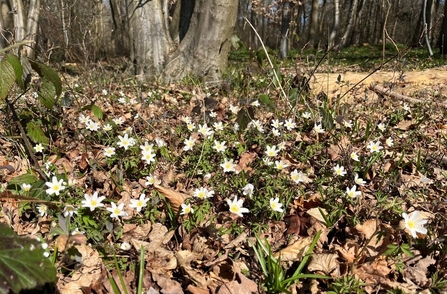
Wood Anemones at Astonbury Wood © Iain Ward
February 2025
The early February work party saw a full house of volunteers, which was good as there was a fair amount of work that could be done. The plan was to coppice three large collapsing Hazels in the north of the wood, to complete a group that had been started last year; remove a fallen but hung up Ash from over a path; and finally cut an area of bramble beneath the Hazels where Common Spotted-orchids were once recorded by Richard Pople - who carried out the bird survey for us at Astonbury last year – albeit over 30 years ago. The weather was kind to us, we got everything finished, and the volunteers made some fantastic woven deer baskets around the coppice stools. The whole area has really opened up post coppicing so it will be interesting to see what grows there in the spring, and over the next couple of years.
We were working close to a very large Ash, probably the largest tree in the wood, and a personal favourite of mine. Out of pure curiosity, Andy decided to measure the circumference with a stick, and worked out the diameter to be 170 inches. Growing at roughly two inches a year would make the tree about 360 years old!
I returned to Astonbury the following week, just to check the tasks I had planned for the next work party were still looking achievable. There was a spring like feel in the wood, Snowdrops were in full bloom and the Bluebell leaves had doubled in height since my last visit. I thought I’d have a look for any sign of a couple of plant species that have been historically recorded in the woodland, but for which there have been no recent records. I had approximate locations, but wading through the brambles I could only see Bluebell leaves poking through the humus. I did however flush a pair of Woodcocks out from their cover in the brambles, and while I don’t like the thought of having disturbed them, it’s good to know they are there!
Finally, we have a couple of events open for booking. On the 9th of May we will be holding a Dawn Chorus Walk, which you can book on by following this link: https://hertswildlifetrustevents.org.uk/event/9may25-dawn-chorus-at-astonbury but you might have to be quick!
And on the 19th of August we’ll be holding a Scything Workshop, where you can come along to learn all about traditional meadow cutting, and have a go yourself! Again, booking is via the following link: https://hertswildlifetrustevents.org.uk/event/19aug25-scything-workshop
January 2025
At the start of this New Year, it definitely feels like Astonbury Wood has gone full circle through the seasons, and begun another round, since I started this job as Woodland Officer at HMWT. It feels like quite a long time now since I began, but what’s really amazing to think is how many annual cycles Astonbury Wood has grown and lived and changed, very slowly, over and over through time. Centuries have passed since coppicing would have first been carried out, and the drovers track would have been used to run cattle from Aston to market at Datchworth, and for some reason Astonbury was largely spared the axe and the plough, to remain to this day, one of those all too rare places we now know as ancient semi-natural woodland.
Time seems to speed up towards the end of each year, before momentarily stopping around midwinter celebrations, only to slowly get going again as we resume our normal lives, and everything falls back into that familiar rhythm. A UK woodland very much follows this same routine with the first signs of spring visible from early January, if you’re there to see them. The group who joined me for an amble around Astonbury in mid-January were. Sadly, there was no Mistle Thrush calling from the top of the tallest Ash at the northern end of the wood this year, but we did see early Snowdrops, Bluebells pushing through the leaves, and a Primrose in flower in one of the glades. A very early nectar source on this occasion, the common name Primrose comes from the Latin ‘prima rosa’ meaning the first rose. While not a rose, it does make a nice reference to one of the first flowers we see in the spring. It was very pleasant after the walk to be able to visit the coffee shop at the Rose and Crown, where Jim kindly bought Callum and myself from the Trust a Coffee!
On another note, I recently received a report of the birds of Astonbury during 2024 which was compiled by a local RSPB volunteer who visited Astonbury a couple of times per month throughout the year. There is nothing out of the ordinary in the records, and it was slightly negative in places as it compares the wood now to when it was last surveyed in 1986. But the sad reality is a decline in species virtually all over the country during the past 40 years. The overall conclusion of the report reads: “Throughout the year the bird species have remained positive and much the same on every visit, with a few single species being recorded. It‘s been a very enjoyable year. The predominant species this year have been: Robin Erithacus rubecula, Wren Troglodytes troglodytes, Blackcap Sylvia atricapilla, Chiffchaff Phylloscopus collybita, Jackdaw Corvus monedula, Carrion Crow Corvus corone, Jay Garrulus glandarius, Common Buzzard Buteo buteo, Great-spotted Woodpecker Dendrocopos major, Mistle Thrush Turdus viscivorus, Moorhen Gallinula chloropus, Tawny Owl Strix aluco.” Hopefully with continued habitat restoration and conservation work, we can see an increase in number of birds using the wood, and indeed the return of some species that have been locally lost.
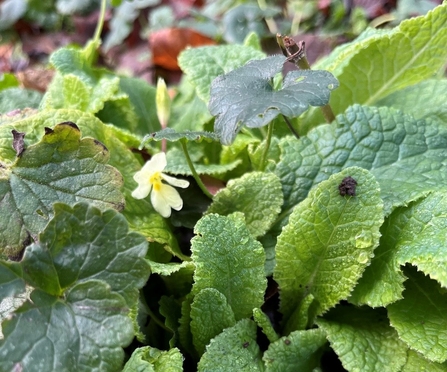
Primrose © Iain Ward
December 2024
December was a busy month working on designs for the new interpretation panels we are planning to install early this year, so keep an eye out for that! We are also putting together a self-guided walk booklet for which I needed to take various photographs at Astonbury. I tried on a Thursday in late November, but despite it being cold and frosty, the sky was very overcast so I wasn't able to get any good pictures. The next afternoon I visited had excellent lighting, so I was able to get some fantastic photos!
We were recently granted a felling licence by the Forestry Commission to carry out 04. Ha of Hornbeam coppicing at Astonbury. The licence comes with the following obligations, which I must say I very much approve of: 1. The land on which the felling took place is to be managed in accordance with the rules and practice of good forestry so as to secure restocking with 100% hornbeam to achieve not less than 1100 stools per hectare evenly distributed over the site by coppice regrowth. 2. All licenced trees felled are to be removed quickly and carefully so as to avoid damage to the remaining tree stumps, seedlings or coppice shoots. 3. The land is to be adequately cleared of lop and top as required, prepared ready in accordance with good forestry practice and weeded to facilitate coppice regrowth and weeded to facilitate natural regeneration or coppice regrowth. Any preparation or weeding must be done in a way so as not to damage existing trees, of any age, on site.
4. If before 30th June two years after felling where natural regeneration fails, or coppice stools fail (as specified under condition 1 above) to establish the minimum stocking density, the land is to be planted or sown before 30th June the third year after felling in order to secure a stocking density of not less than 1100 stools per hectare of 100% hornbeam evenly distributed over the site. 5. For a period of 10 years from the restocking: a. The plants must be protected against damage and be adequately weeded. b. Any failure or losses should be replaced as necessary to provide a stocking of not less than 1100 stools per hectare evenly distributed over the site. c. Any stems subject to the conditions of this licence must be properly maintained in accordance with the rules and practice of good forestry.
The December work party had fewer volunteers than normal on what was a rather murky Thursday. The six volunteers that did make it got on very well nonetheless. We started off by clearing some scrub and small trees from the southern edge of the north eastern pond in the wood to let a bit more light in, but not too much, as this is being kept as the woodlands' sheltered pond. Once we finished there, we walked down to the glade with the Midland Thorn to coppice a lone Hazel. The volunteers made a fantastic deer basket, taller and wider than previous versions. And it's looking like this is how they need to be, seeing what Muntjac appear capable of reaching to eat. It's nice to hear the comments that come with this task about it being nice doing something creative at a work party.
Finally, on a visit to Astonbury to check and map the new deer fence around the Hazel coppice, I bumped into Kerry Robinson, one of the most expert fungi recorders in the county. She was out looking for fungi after what’s been quite a poor year for them. She told me she's recorded nearly 800 species at Astonbury to date!
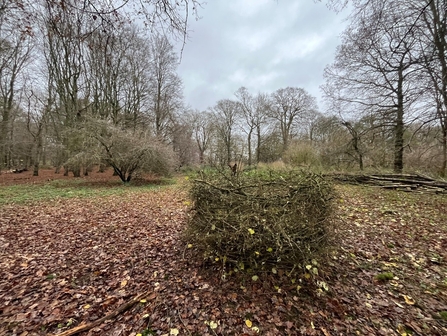
Deer basket c Iain Ward
November 2024
I don’t know how many of you will have managed to visit Astonbury Wood this past month, but it’s been glorious this autumn! Yes, it has seemed relentlessly gloomy at times, but the cause of this “Anticyclonic gloom” – a high pressure system – gave us quite possibly the calmest and driest November for quite some time. This allowed all the golden, brown and orange leaves to fall to the ground quite undisturbed by wind or rain, and there they stayed, giving a brilliant hue to the air in the woods, even on the dullest days!
While the trees have been dropping their leaves, we’ve had a team of forestry workers removing some diseased Ash trees along the eastern edge of the wood. The unfortunate removal of these trees was due to their infection with Ash dieback, and their proximity to the bridleway outside the wood. Ash dieback is caused by the fungus Hymenoscyphus fraxineus which weakens and eventually kills many Ash trees making them more susceptible to limb or stem breakages. Ash dieback has been in the UK since at leased 2012 but possibly earlier, and is steadily killing Ash trees all over. At the Trust we try to retain Ash trees where it is safe to do so, in the hope there will be some resistance.
What seemed to be the first sunny day for some weeks coincided nicely with a work party. 12 enthusiastic volunteers had a great day clearing Brambles, Sycamore and Elder scrub around the southern edge of the pond in the north west of the wood, and cleared some more young Sycamores by the north western entrance to build a dead hedge to extend the fence line. I left the volunteers to it in the afternoon while I made some adjustments to the vehicle gate at the southern entrance to the woodland, in order to make it open inwards rather than outwards, as the forestry workers had struggled to get a tractor and trailer in and out. On my way back up to the volunteers I saw a butterfly. It was a Comma, and the first record of one at Astonbury this year. In fact, the first since 2007, and on the 12th November!
As we are speeding towards the end of the year, I’ve been thinking about the New Year we’re approaching, and planning some events in. We’ve got three guided walks planned in so far. You can have a look at these and book on by visiting these web pages:
A Winter Amble Around Astonbury - https://www.hertswildlifetrust.org.uk/events/An-Amble-Around-Astonbury
Dawn Chorus Walk - https://www.hertswildlifetrust.org.uk/events/dawn-chorus-astonbury-12apr25
Bluebell Walk - https://www.hertswildlifetrust.org.uk/events/bluebell-walk-27apr25
This will likely be my last entry this year, so I hope you all have a very merry Christmas and a happy New Year!
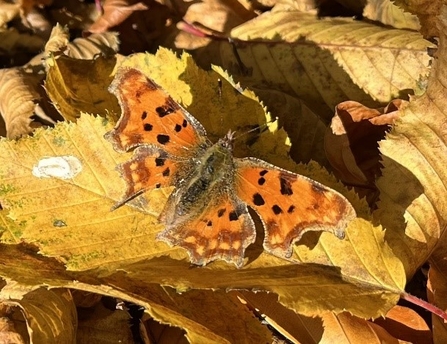
Comma at Astonbury Wood © Iain Ward
October 2024
The lane to Astonbury Wood was underwater one morning early this month as I drove to meet Andrew Clark, a tutor of Forestry and Arboriculture at Capel Manor College. Luckily the woodland wasn't yet as flooded, despite having about two months' rain in one week. I showed Andrew to the area of young Sycamore (a non-native but naturalised species) I'd like felled to open up a glade in the east of the wood, and he thought they'd be perfect for the students to have a go at, which is what I'd hoped. He said they'd likely come along to do some felling in about 3 weeks, which is sooner than expected and a felling licence would likely be required. I suggested I could mark up about 40 of the stems to be felled this year to keep the timber volume under 5 cubic meters. Andrew said that should work well as there are about 20 students. He was even keen to have the wood if he could work out a way of extracting it, as they are always looking for timber to use for the firewood processing course they run at Capel Manor. After I left Andrew I went down to the southern entrance as I'd seen recently that someone had kicked one of the rails off the chicane, so I nailed it back on, this time with much bigger nails.
It turned out Capel Manor students hoped to make a start with the work at Astonbury even sooner than expected. Andrew emailed to say they would be doing some felling starting 8th October. Due to the earlier than expected start, I hadn't been to mark the trees yet, or even purchased any paint for that matter. After sourcing some emergency marker paint, I went over to Astonbury to mark about 40 Sycamore stems. It rained heavily afterwards, so I was left hoping the paint wouldn’t have washed off! I’ve not had any report from the college that the marked trees were hard to locate, rather that the students have been getting on well, and expect to be returning most Tuesdays until Christmas for their practical sessions.
On Saturday 12th October, local Tree Enthusiast and volunteer Andy Holtham lead a tree gall walk at Astonbury. Tree galls are often overlooked, with probably the most famous being the Oak apple. Galls tend to be caused by various species of tiny wasps that manipulate tissue in a plant to make it a suitable home for larvae to feed and develop. I was away when Andy lead this walk so unfortunately wasn’t able to attend, but he tells me that it went well, it stayed dry, and the group found 9 types of gall on their walk!
The following week I arranged a meeting with Tim - Conservation Manager at the Trust - at Astonbury after not succeeding to get a local Amphibian and reptile recorder to come and assess the ponds. I was aware that Tim has done, and still does a lot of projects with ponds around the county. I found the meeting most useful! For the most part Tim liked what he saw with the ponds at Astonbury, with the marginal vegetation and deadwood in the water, he also said the water was very nice and clear. Leaf litter and silt were an issue as was shading, but nothing too terrible. Tim advised getting a dragonfly survey done next summer and an Amphibian and reptile survey starting very early spring, to get a baseline before carrying out any drastic work. He's kindly given me the details of a few people I can contact to help with this. However, if you are reading this and have a particular expertise in dragonflies, and would like to carry out a survey next year please do contact me at iain.ward@hmwt.org.
17th October saw a volunteer work party at Astonbury, which 10 volunteers attended. One task was to make a couple of adjustments around the southern vehicle gate, namely removing the bank of soil from one side of the track, and moving one of the pedestrian chicane posts away from the track to widen the access. Two volunteers made an excellent job of this. There was also cutting and raking to be carried out to the glades along the central ride. The other volunteers split into groups, and likewise made an excellent job of this.
Finally, thanks to all who attended the Aston Village Society AGM, and stayed to hear my update about the Ancient Astonbury project so far. It was great to see so many people there, and I was most grateful at being given the opportunity to speak!
September 2024
One evening at the end of August, we held a Bat Walk at Astonbury. This was very kindly led by Chantal from Herts and Middlesex Bat Group. We had 10 people come along, meeting at 7:30pm at the Three Horseshoes carpark opposite the southern entrance to Astonbury, where I gave a brief introduction to the Wood before handing over to Chantal who gave a wonderful short talk about bats and how we could detect them. Bat detectors were then handed out for everyone to have a go, and Chantal had a little device that could produce very high frequency sound that bat detectors can be tested with. Most bats echolocate at frequencies far above what adult humans are able to hear which is generally 15-17 kHz. Common Pipistrelle for example echolocates at around 45kHz, Soprano Pipistrelle at about 55kHz. Knowing the frequency of the sound you are picking up enables you to tell which species of bat is close by.
The sun had just about set but it was still very warm when we crossed over to the entrance of the reserve. We waited a short while by the Stevenage Brook but didn’t pick up any bats, presumably it was still a bit too light, and there were just a few late calling birds. It was much darker once we got into the woodland, and it wasn't long before we got to a glade and picked up first, Common, then Soprano Pipistrelle, both flying about overhead. We were in the glade so were able to watch the bats hunting against the sky above us. Chantal explained bats make a different sound when they catch prey, different to the sound produced when hunting with echolocation. She called this a feeding "buzz", and we were able to pick a few up through the bat detectors. We left the two Pipistrelles hunting in the glade and returned to what was now close to full darkness below the tree canopy. It wasn't long before Chantal called to everyone to set their bat detectors to 35kHz to pick up the sound of a Brown Long-eared bat, which was there for just a few seconds, then gone. But in its place, slightly lower at 32kHz we were able to pick up the "click-click-click" of a Barbastelle. Chantal explained that Barbastelles often fly quite long distances from their roosts to hunt, but as it was still relatively early in the evening it was likely this individual had a roost within Astonbury. Chantal went on to pick up several more Barbastelles with her slightly more advanced bat detector, but once we got down onto the path alongside the Stevenage Brook on the way back out of the wood we didn't pick up any more bats. The trees are much younger on this side of the wood, existing from 1950s planting, so of no real value as far as bat habitat is concerned. So that was the end of a fantastic introduction to bats at Astonbury. Afterwards we made plans to put a static detector back up at Astonbury later this week, as Chantal is curious about the relatively high level of Barbastelle activity!
A few days later we returned to put a bat detector up. First, we looked for older trees with decay around the main pond, but not too close to it, and under the woodland canopy so as not to pick up only Pipistrelle echolocation. We found a Hornbeam with a good-looking collection of cavities in the base about 20 meters north of the pond and went of that. Not too far away we found an Ash with an impressive cave-like cavity in the base, and a large dead-standing Oak with plenty of peeling bark and Woodpecker holes. I'm looking forward to seeing what is recorded!
I’m becoming aware of autumn/winter approaching, so I wanted to make sure I had a reasonably sized potential coppice area mapped, should the opportunity arise for the work to be done. A larger area will be beneficial to get more light into the wood and generate more timber to go for charcoal, as well as lessening the effect of browsing on the regrowth. I extended an area I'd previously mapped to include some additional previously coppiced Hornbeams. The area mapped ended up at about 0.4Ha but Hornbeam stools were sparse, with only about 60 present. A density of 500-1000 stools per Hectare would be preferable, so a minimum of about 200 in this particular area. However, the Hornbeam and Ash regeneration that's come through in the coupe we cut this year looks really good, so I'd expect the same to be the case for this compartment. Retaining approx. 6 standards in a coupe of this size would also be ideal. Once I had the area mapped and notes taken I went and tidied up and removed litter from an antisocial fire site I had spotted in the Woodland when we were looking for an appropriate location for the bat detector.
The bat recorder had been up for about a week and a half at Astonbury, and as we had it on loan for about 3 weeks, this seemed a good time to move it, to see if there might be other bat species elsewhere in the wood. I met Chantal and we took the recorder down from its location close to the large pond. It was showing 9MB of recordings which Chantal said was really good! We looked in the north of the wood for a place to put it, where no bat recording has previously been carried out to my knowledge. There is a pond at either corner of this northern end of the wood, and a reasonable abundance of old trees, so it looked good for bats. We put the bat recorder up a Hornbeam close to the western pond with some large old Oaks and Ashes with plenty of deadwood and holes nearby. On the way out of the wood I noticed an oak seedling totally white with Powdery Mildew. This is caused by the fungus Erysiphe alphitoides and has been particularly prevalent this year with the wetter than normal weather early in the summer. It is thought this fungus could be a major contributor to the current lack of Oak regeneration seen in our woodlands.
September is over already; the year is passing in a flash! While I’m all the more aware of the track at the north of the reserve steadily becoming overgrown making access difficult for our surveyors. As the ambiguous statement on our tenancy says "we must maintain the access track if nobody else does." Somewhat surprisingly, it doesn't seem like anybody else does, so I spent a whole day scything the track and parking area and cutting the hedge. It was great weather for scything and thoroughly enjoyable, but in hindsight it could have been a good task for a work party! Next time perhaps. Popped into the reserve at lunch time and saw a Silver-washed Fritillary.
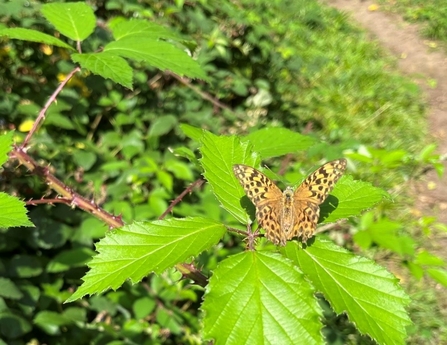
© Iain Ward
Due to the deer browsing, we had a meeting with a fencing contractor to look at deer fencing this years’ coppiced area. He advised the heavy-duty plastic mesh I was looking at using, was not up to the job. However, he's agreed to supply galvanised metal fencing for not ever so much more, so hopefully he'll be able to do the work for us at the beginning of November.
Finally, if you like the sound of learning about the world of the often-overlooked tree gall, we will be holding a walk to take a closer look at these at Astonbury on Saturday 12th October. More details can be found at: https://www.hertswildlifetrust.org.uk/events/tree-gall-walk-12oct24
August 2024
On the very last day of July I helped Andy Holtham with his Summer Tree ID Workshop. We had 12 people come along for the day which started at Aston Village Hall. Andy gave a very thorough and entertaining presentation which kept everybody's attention for a good couple of hours. He had handed out some fresh twigs with leaves of various species at the beginning, and worked through them describing key differences and identifying features. After some questions and lunch, we all went for a walk around Astonbury, so the group could have a go at putting into practice what they had learned during the morning. Andy gave everybody a key to common British tree species that he had produced himself which contained 60 species which was truly brilliant, and enabled easy identification of many of the species we came across. From what I understand everyone who came along enjoyed the day and went away with a good idea of how to identify quite a few common trees!
The predation of the coppice regrowth at Astonbury, presumably by Muntjac has been keeping me awake at night, so I decided to see if I could do something about it. We never managed to finish tidying up in the coppice compartment before the Bluebells were flowering in the spring so I knew there was a bit of material I could make use of, and with what would be quite a small task and no imminent work parties I thought I'd have a go by myself. I decided to go wider and taller with the coppice regrowth protection and took some inspiration from my recent visit to Bradfield Woods in Suffolk, using the branches upright rather than horizontally, essentially making a wigwam like structure around each coppice stool. I only managed to do this on four of the coppice stools that appeared most affected by the browsing, until I ran out of branches. It will be interesting to see if this is effective as I feel it would use less branches and less processing of the branches used. I thought it also had quite a fitting medieval look about it. There is a real abundance of Ash and Hornbeam regeneration all over the ground in the coppice compartment, which I hope will survive, as it'd be great if the compartment was of much greater density of coppice stools the next time it is cut in 10 - 15 years’ time. Hopefully in the near future we’ll be able to Deer fence the whole area! I shared what little sun there was today while I was working with a Speckled wood, a Silver-washed fritillary and a Southern Hawker. I also watched a Grey wagtail for a short while, flitting around the pond as I was leaving the wood.
On the 20th August I ran a scything workshop at Astonbury which I had two people sign up for and attend. We had dry weather and it wasn’t too hot, so just about perfect conditions for a few hours of scything. After the Obligatory health and safety briefing I talked the two volunteers through the basics of using a scythe and how to keep it sharp. Without delay we set off into the woodland and to the area I had planned to cut, which is the glade around the watercourse in compartment 3. The two volunteers got to work and both looked like naturals with a good rhythmic swing of the scythe through the nettles. The three of us progressed quickly, and after about an hour, had the majority of the area cut. The area closest to the path on the southern side of the watercourse is becoming dominated by Sedge, but further away from the path there is quite a lot of finer, grassy growth coming through. It's certainly looking better than when we previously cut it in November last year. After a short break we got back to work and finished the cutting, and finished by raking off all the cuttings which we piled up in the shade. I had intended to finish the workshop at 1pm, but was very grateful the two volunteers offered to stay an extra hour until the task was completed! There was agreement among us of the pleasantries of scything over brush cutting. Hopefully more areas of Astonbury can be brought back into a cutting rotation suitable for a scythe!
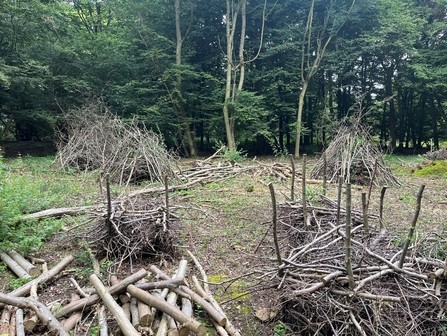
July 2024
After all the rain we had during the spring followed by intense sunshine seemingly brought about by the Summer Solstice, the Hazel regeneration is looking good at Astonbury, and the paths had become rather overgrown. Lucky then that myself and Sam had 8 willing volunteers to lead through a day of path cutting at Astonbury. It was one of those summer days when staying in the shade was really the only feasible way of spending much time outside, fortunately in this instance Astonbury is currently virtually a closed canopy woodland, making the work for the day relatively comfortable. All went well, apart from late in the day when Sam came across a dead Buzzard beside the path. No signs of having been shot; accidentally poisened perhaps? It's not uncommon for rodents to be poisoned around farms, making seemingly nice easy pickings for our poor birds of prey.
A couple of days later I returned to carry out a survey of the Ash trees within falling distance of the bridleway along the eastern edge of Astonbury Wood which is a Medium Risk Zone, thus surveyed every second year, but due to the sometimes-rapid decline of Ash due to Ash Dieback, Ash trees are surveyed annually. One tree was identified that required fairly urgent work and another group that would likely require work more urgently by next year. Because of access and location, the trees will best be grouped together and the work carried out in one go.
In early July I received the results of a botanical survey at Astonbury that had been carried out over the spring. The completed survey looks great and includes 37 Ancient Woodland Indicator species! The following day I received the results of bat recordings taken at Astonbury between 26th April and 2nd May 2024. A fantastic total of six different species were recorded including Barbastelle. This information will really help with planning the future management.
The following week we were back for a work party with 10 volunteers. We had a tiny bit of path cutting to finish off along the main ride so I got a couple of willing volunteers to do that, while the rest of us tackled scrub and a large area of Nettles on enriched ground. One reason for the work was to open up a view of a Midland Hawthorn, which is a less common tree to find in Hertfordshire. The other was to cut and rake an extensive area of Nettles in the hope that a cycle of cutting and raking will make this area to become a more species rich glade. Only time can tell. A rather damp but very humid day, but none the less a perfect day to be in the woods in July!
Finally, why not book yourself a place on the Scything Workshop at Astonbury on the 20th August or the evening bat walk on the 28th? You can find out more information here: https://www.hertswildlifetrust.org.uk/events/traditional-woodland-management-20aug24
https://www.hertswildlifetrust.org.uk/events/bat-walk-astonbury-wood-28aug24
June 2024
I hadn't been to Astonbury for a couple of weeks due to a period of annual leave, followed by a catch up on admin work upon my return, and involvement in several work parties at other Trust reserves.
I received an email at the beginning of the month from Richard, our bird surveyor at Astonbury, saying he felt the access track at the northern end of the wood was becoming tight with growth from the hedges, and the footpath down into the wood was also closing up with vegetation. We were still about three weeks from our next work party and I had largely caught up on admin, but with no one else available I opted for a solo site visit. Upon arrival I was greeted with several Bee Orchids in flower in the old field centre car park and the sound of the first Cuckoo I'd heard in Hertfordshire this year! As I was lone working, I opted for hand tools, so did the cutting back largely with a scythe. Such a pleasant way to work! It was so refreshing to cut to the sounds of birdsong and without constant two-stroke fumes! After spending the morning cutting and raking the access track and footpath that leads into the wood past the old field centre, I carried out a bit of a site check.
Foxgloves were in flower, Hazel regrowth was coming through in the areas we had coppiced during the winter, and a lot of Small Teasel was coming up in the glades we are restoring. When I got down to the southern end though I was shocked to see how much Himalayan Balsam there was growing along the bank of the Stevenage Brook, and Giant Hogweed too! These are two non-native invasive species or INNS that outcompete our native flora. Unfortunately, this is an ongoing issue, with seed sources further up the Stevenage Brook. Luckily the River Beane Restoration Association are doing a great job on eradicating these, so hopefully we can clear the banks of the Brook adjacent to Astonbury in the near future. The Trust is also trialling an innovative biological approach to the problem of Himalayan Balsam and you can read more about that here: https://www.hertswildlifetrust.org.uk/news/tackling-himalayan-balsam-our-rivers-beautiful-enemy
We have a work party in the last week of June to cut back some of the paths around Astonbury, so hopefully by the time you’re reading this, you will have found it slightly easier to walk around!
If you would like to join one of our work parties at Astonbury Wood in future, please register your interest at https://hertswildlifetrust.formstack.com/forms/hmwt_volunteer_enquiry_form
May 2024
Astonbury really came into bloom in the past couple of weeks and the woodland was full of flowers when I had a walk around with the old Astonbury Wood Management Group on the 25th April. It was great to learn from them about the management they had carried out in the past, and equally nice to hear how positive they were about the work the Trust has carried out over the past six months. We saw the glades we cut now filling with the blue flowers of Bugle and a lot of the locally scarce Small Teasel. We once again saw Orange-tip butterflies around their Garlic Mustard food plant, and we appropriately found ourselves surrounded by St Mark’s Flies, on St Mark’s Day.
On Sunday 28th of April we held a Bluebell walk at Astonbury. I was considering cancelling this walk on Sunday morning as it had rained all night, and was still raining heavily at 8am. I knew the woods were going to be very wet and slippery! I phoned a few of the people who had registered to gauge enthusiasm and the people I spoke to were nothing but enthusiastic! So, the walk went ahead. By the time we met at 9:30am the rain was much lighter and it actually stopped raining for the duration of the walk, with the sun, at times, poking through. There was a group of 11 of us in the end, with nine that didn't make it. I can't blame them as the weather and the forecast for the day were pretty awful. The Bluebells were past their best but there was plenty more to look at! I thoroughly enjoyed showing this very enthusiastic group around Astonbury with the help of Anna - Reserves Officer for Trust - as the back marker, and there were smiles all around! Only two members of the group had been to Astonbury before, so it was nice to be introducing the site to a new group of people. We finished at The Three Horseshoes pub for complementary teas and coffees, where it was great to see conversations about the visit to the wood continue among the group.
On Saturday 4th May, 10 people made the early start for the Dawn Chorus Walk, which was led by Richard, Astonbury's volunteer bird surveyor. We first stopped by the Stevenage Brook at the southern entrance to the wood to listen for the Kingfisher that often flies up and down there, but no luck on the day. It was still twilight as we entered the wood with a Robin, Great Tit and Song Thrush calling. Next stop along the western path we heard Blackcap followed by Chiffchaff and a Green Woodpecker. Richard told the group he had seen one pair of Blackcaps looking to nest in the wood and three separate males singing. As we got away from the traffic noise - even at 5am! - we heard Wren, Mistle Thrush and Great Spotted Woodpecker. Again, Richard was able to tell the group he had seen three pairs of Wrens nesting in the wood. Arriving at the Hazel coppice clearing we were greeted with Nuthatch, and had Wren and Song Thrush always calling in the background. Back down to the southern end of the wood via the central ride, we finished with Goldcrest in the Thujas. A lovely early morning amble round the wood, with those who came expressing how nice it had been to learn some birdsong they could now recognise. Anna had been a great backmarker and stayed behind with me to take down the bat recorder and count Early Purple Orchids. We counted 69!
Finally, why not book yourself a place on the Summer Tree Identification Workshop we are holding at Astonbury on the 31st July? You can find out more information here: www.hertswildlifetrust.org.uk/events/summer-tree-identification-workshop-31jul24

